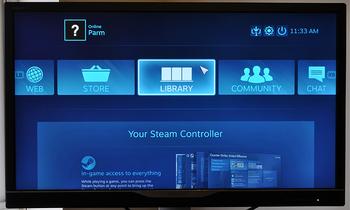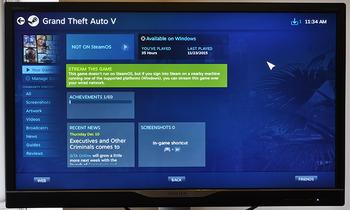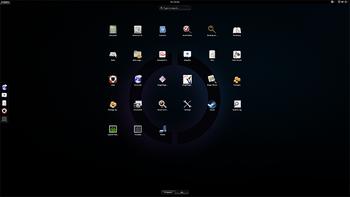The ins and outs of SteamOS
We suppose the most pertinent question is why would you want SteamOS? In a nutshell, the operating system is designed exclusively for Steam Machine games consoles, and as such is geared for big-screen navigation and none of the superfluous features you'd come to expect from, say, Windows 10.
Sounds useful yet when you first boot to the SteamOS home screen there's a real sense of deja vu. Understandably so, as SteamOS looks and feels practically identical to the 'Big Picture' mode available via the Steam client on any PC.
How does it work? Developer Valve has taken a Debian-based Linux operating system and placed Steam on top. There's no magic so to speak, but then there doesn't need to be - Big Picture mode is an excellent way of browsing your game library, particularly from the couch with joypad in hand.
Login to your Steam account and your friends list and cloud saves will carry across, and most existing users will automatically have access to a vast catalogue of titles that have been amassed over the years. Add to that a web browser, built-in chat and one of the biggest digital game stores known to man, and you have a pretty useful solution.
Or do you? It has been a while since we last spent some time with SteamOS, and we are genuinely surprised to find that the operating system hasn't made meaningful gains in terms of catalogue and compatible content. One obvious reason is that the majority of Windows games won't function on Linux without developers adapting their software to work, and few seem to have made the effort.
Want to play the likes of Fallout 4? The Witcher 3? Grant Theft Auto V? You're out of luck, and you'll simply get an ironic message stating that the game isn't natively supported on SteamOS but can be streamed from a Windows PC. We should point out the fact that there are thousands of compatible titles available, however triple-A exclusives are conspicuous in their absence and SteamOS is in need of a system seller or two.
Confounding matters further, the lack of content isn't only applicable to games. As it stands, there are no native apps for the likes of Netflix, BBC iPlayer or Spotify, and no built-in media player. You can use the web browser to playback HTML5 video, yet that's hardly ideal for an interface designed to be used by a joypad. From a multimedia perspective, SteamOS remains a distant second to an Xbox One or PlayStation 4.
And that's a problem. From a living-room convenience point of view, the aforementioned games consoles have the upper hand while costing considerably less, and in the high-end space, similarly-priced Windows PCs offer greater functionality and wider compatibility with the latest games.
The holes in the SteamOS library combine to create a frustrating experience for the average gamer, however there are other attractions for enthusiasts or hobbyists. Configure SteamOS to allow you to switch to desktop mode (settings, interface, enable access to the Linux desktop) and you can drop into a full Linux environment, from which you can install software and tweak settings to your heart's content.
There are clearly pros and cons, yet while SteamOS arguably isn't ready for the mainstream, there are signs of potential. We quite like the fact that the software is streamlined and geared toward gaming - it doesn't have as many prompts or updates as Windows - and most of the current limitations can be overcome with further development.






